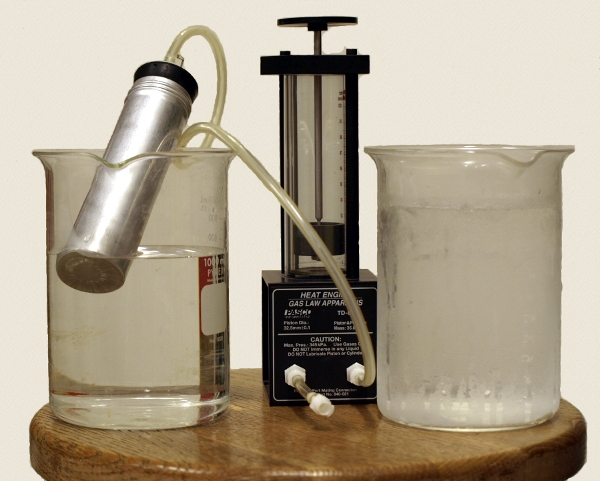PASCO: “The heat engine consists of a hollow cylinder with a graphite piston that can move along the axis of the cylinder with very little friction. The piston has a platform attached to it for lifting masses. A short length of flexible tubing attaches the cylinder to an air chamber. The air chamber consists of a small can sealed with a rubber stopper that can be placed alternately in the cold reservoir and the hot reservoir.”
This demo shows how a heat engine transforms thermal energy into usable work. It can be used to lift small weights!
Materials
- Piston apparatus + aluminum can and rubber stopper
- Short rubber hose (as shown in picture)
- Ice water bucket (best to have a combo of water and ice)
- Hot water boiler
- 500 – 1000 mL beaker for hot water
- Thermometer
- Small mass ~100 g (optional)
- Video camera (large classes)
Demo
- Start the hot water boiling (takes about 5 min) and prepare the ice water bath.
- Connect the aluminum can to the piston apparatus with the rubber hose.
- Open up both white clamps underneath the piston, and position the piston wherever you like. Be sure that the set screw at the top of the apparatus is not tightened (else the piston will not be able to move freely).
- Clamp shut the tube which is not connected to the can.
- Fill a beaker partway with hot water (60 C is fine). The ice water bath should be at 0 C.
- Place the small mass on top of the piston, if desired.
- Submerge the aluminum can in hot water – the piston will rise!
- Now submerge it in cold water – the piston will fall!
Explanation
This apparatus demonstrates thermal expansion of gaseous materials; specifically air inside of a hollow metal cylinder. A material of any state is heated, molecules within the material begin to vibrate (they gain kinetic energy), thus will move around and the material will expand. When cooled, such materials will contract as there is less kinetic energy in the molecules and therefore there is less movement.
Thermal expansion can occur linearly and volumetrically. In this such case, we see volume expansion occurring. Volume expansion occurs in all materials when heat is added to a system. The change in volume is therefore proportional to the change in temperature.
Giving,
where represents the coefficient of volume expansion, measured in 1/C. This is approximately 3400×10^-6 for air and most other gases at standard atmospheric pressure.
Therefore, this law governs the Heat Engine! When the cylinder is placed in hot water, heat energy is transferred to the metal and the air within, thus the air will expand and pressure will increase, due to the ideal gas law:
the pressure will also increase as the temperature increases. When the pressure increases it pushes through the hose and puts an upward force on the piston. This piston will have a gravitational force pressing down on it from the mass, but the pressure force (upward) will be greater and accelerate the mass upwards.
When the cylinder is then rapidly cooled by placing it in the ice bath, the air within will contract and the pressure will decrease, thus the pressure force (upwards) on the mass will decrease for a fixed area, causing the mass to accelerate the piston downwards again.
Notes
- Ice can be obtained from the second floor of Thimann Labs
- TURN OFF the hot water when done with the demo!
- The larger the temperature difference between the hot and cold bath, the more the piston moves!
- The full manual for this apparatus can be found here: http://fisica.uc.cl/images/TD-8572_Ley_de_Gases.pdf
